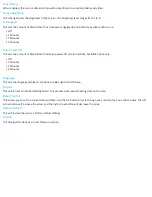
1. Preparation
1.1 Battery Installation
Important: only use 3.7V 18650 rechargeable lithium-ion batteries.
Do not remove the battery compartment cover while the device is powered on. Ensure the device is powered off before proceeding.
To open the battery compartment, press the battery cover tab toward the battery compartment, then lift outward to remove the
cover. Positive and negative terminals are labeled inside the compartment. Orient the battery’s positive and negative terminals with
the compartment’s terminals. Once the battery is seated, replace the compartment’s cover.
1.2 The I/O Panel
The I/O (Input/Output) panel consists of a USB-C port and a MicroSD card slot. The panel is located on the scope’s right grip. To
access it, pull the tab on the left side of the protective cover.
1.3 Charging the Battery
To charge the battery, use the supplied USB cable with a USB power source or charging adapter. Attach the cable’s USB-C plug into
the I/O panel’s USB-C port. Insert the cable’s Type-A connector into a charging adapter’s USB port. Plug the charging adapter into an
AC outlet to begin charging. An image of a charging battery will appear on the scope’s viewing screen showing the charging status.
When the status reaches full capacity, the charging cable can be disconnected.
1.4 Recording Media
This device uses MicroSD media (also called TransFlash or TF) for recording photos and videos. MicroSD cards up to 32GB may be
used to record and store files. In order to ensure proper performance, only cards with speed class 10 should be used.
To insert a MicroSD card, align the card with the card slot so that the card’s smaller end with the metal contacts are facing the slot,
and the printed surface of the card is facing up. Gently push the card into the slot. Be careful not to force the card, as this could
result in damaging the card and jamming the slot. When the card is fully inserted, there should be a click.
To remove the MicroSD card, push the card inward to activate the release. The card will partially eject so it can be pulled out. Do
not remove the card while the device is recording, as this will result in loss of data.
2. Operation
This NVB series night vision scope uses a highly-sensitive digital imaging sensor to display live video on a viewing screen. The scope
can use ambient light and its built-in infrared lamp to view and record in settings with little to no light. The rear of the scope con-
sists of a viewing screen and a control panel, while the front of the scope consists of an objective lens and an infrared light source.
2.1 The Control Panel
The control panel is located on the top of the device, above the screen. There are six buttons which control power, switch recording
and exposure modes, capture images, and manage the device’s settings.
2.2 Powering On/Off
To power on the scope, press and hold the power button for approximately 2 seconds. Once the screen displays an image, you can
release the button. To power off the device, press and hold the power button for approximately 2 seconds. Once the screen begins
to turn off, you can release the button.
2.3 Focusing
While the night vision scope is powered on, a live image will be displayed on the viewing screen. To control focus, adjust the focus
ring located on the front left of the scope. Rotating the ring clockwise will focus closer while rotating the ring counter-clockwise will
focus farther.
1
Viewing Screen
9
Infrared Lamp
2
Power Button
10 Battery Cover Tab
3
Menu/Mode Button
11
Battery Compartment
4
Exposure Mode Button
12
Tripod Port
5
OK Button
13
USB-C Port
6
Left Arrow Button
14
MicroSD (TF) Card Slot
7
Right Arrow Button
15
Strap Bracket
8
Focus Ring





